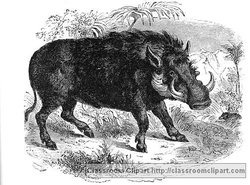Warthog
|
|
| Warthog | ||||||||||||||
|---|---|---|---|---|---|---|---|---|---|---|---|---|---|---|
| Scientific classification | ||||||||||||||
| ||||||||||||||
| Binomial name | ||||||||||||||
| Phacochoerus africanus (Pallas, 1766) |
The Warthog (Phacochoerus africanus) is a wild member of the pig family that lives in the plains and open woodlands of Africa. They are the only widely recognised species in their genus, though some authors divide them into two species. On that classification, P. africanus is the Common Warthog and P. aethiopicus is the Cape or Somali Warthog.
Warthogs are identifiable by the two pairs of tusks protruding from their mouth, which are used as weapons against predators. Warthogs derive their name from their short, almost wart-like, horns. They eat grass, berries, bark, roots, and carrion, as well as insects and grubs.
They range in size from 0.9 to 1.5 metres (2.9-4.9 feet) in length and 50 to 150 kg (110-330 pounds) in weight.
| Contents |
Sociality
A grouping of warthogs is called a sounder. Common warthog sounders are usually composed of 3 to 10 animals, although groups as large as 30 have been anecdotally reported. The "core" of the sounder is usually a sow with offspring. A sounder can be composed of multiple males and their respective offspring, and females tend to stay with their family group for several breeding seasons.
On the other hand, males tend to live alone or in small bachelor groups with individuals that come and go, but they tend to stay within their natal range. Mature males only join female groups when sows are in heat. Males are not territorial, but will fight among themselves for mating opportunities during breeding season, sometimes inflicting significant and serious wounds with tusks.
Ecology
Although warthogs are commonly seen in (and associated with) open grasslands, they will also seek shelter and forage in denser vegetation. In fact, warthogs prefer to forage in dense, moist areas when available. The common warthog diet is omnivorous, composed of grasses, roots, berries and other fruits, bark, fungi, eggs, dead animals, and even small mammals, reptiles and birds. The diet is seasonably variable, depending on availability of different food items. Areas with many bulbs, rhizomes and nutritious roots can support large numbers of warthogs. Warthogs are powerful diggers, using both heads and feet. When feeding, they often bend the front legs backwards and move around staying on the knees. Although they can dig their own burrows, they commonly occupy abandoned aardvark burrows. The warthog commonly enters burrows "back-end first", with the head always facing the opening and ready to burst out as needed.
Warthogs are very fast runners and quite capable jumpers. They will often run with their tail in the air. Despite poor eyesight, warthogs have a good sense of smell, which they use for locating food, detecting predators and recognizing other animals.
Although capable of fighting, and males will aggressively fight each other during mating season, their main defense is to flee by means of fast sprinting. The main warthog predators are humans, lions, leopards and hyenas. Cheetahs are also capable of taking small warthogs.
Longevity
Wild warthogs can live up to 15 years. Captive warthogs may live as long as 18 years. The typical gestation period is 5 or 6 months and the litter size is 2 to 8 piglets, although 2 to 4 is more typical. Piglets are weaned at 3 or 4 months of age, reaching sexual maturity at 18 to 24 months. Females may give birth twice a year.
Clipart and Animal Pictures
- Clipart (https://classroomclipart.com/image/category/clipart.htm)
- Animal Clipart (https://classroomclipart.com/image/category/animal-clipart.htm)
- Animal Animated Clipart (https://classroomclipart.com/clipart/Animations/Animals.htm)
- Pictures of Animals (https://classroomclipart.com/image/category/animal-photos.htm)
- Amphibian Clip Art, Pictures and Photogaphs (https://classroomclipart.com/image/category/amphibian-clipart.htm)
- Farm Animal Clip Art, Pictures and Photographs (https://classroomclipart.com/image/category/farm-animal-clipart.htm)
- Mammal Clip Art, Pictures and Photographs (https://classroomclipart.com/image/category/mammal-clipart.htm)
- Marine Animal Clip Art, Pictures and Photographs (https://classroomclipart.com/image/category/marine-life-clipart.htm)
- Reptile Clip Art, Pictures and Photographs (https://classroomclipart.com/image/category/reptile-clipart.htm)
- Spider Clip Art, Pictures and Photographs (https://classroomclipart.com/image/category/spider-clipart.htm)


